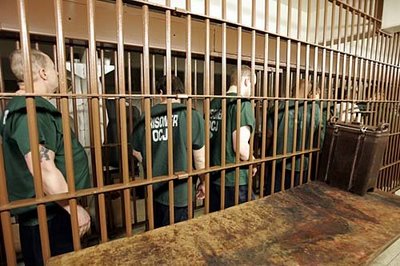Even federal prisons know that their inmates need medication-assisted therapy. So why aren’t they changing?
Megan McLemore
Politico
Today, Gordon Goodwin is in federal prison in Atlanta. Not too many years ago, he was a student at University of North Carolina at Chapel Hill, on track for law school. He enjoyed tennis and mountain biking.
Today, his future looks bleak—failed by prison drug treatment policies that even the Bureau of Prisons admits don’t work, policies opposed by science and medical professionals, including groups like the World Health Organization.
 As criminal justice reform becomes a major topic of conversation in Washington, Goodwin’s journey from would-be law student to prison addict is a cautionary tale of how inmates in the bureaucratic federal system are set up to fail—and how those failures ripple through the prison system and waste taxpayers’ dollars at a time when both states and the federal government are looking to rein in spending.
As criminal justice reform becomes a major topic of conversation in Washington, Goodwin’s journey from would-be law student to prison addict is a cautionary tale of how inmates in the bureaucratic federal system are set up to fail—and how those failures ripple through the prison system and waste taxpayers’ dollars at a time when both states and the federal government are looking to rein in spending.
Because, unfortunately, Gordon’s story—while remarkable—isn’t necessarily an outlier.
In 2009, as a 20-year-old history major at UNC-Chapel Hill, he had a bout of kidney stones and became addicted to oxycodone and other opioid painkillers after taking them as prescribed for only one week. By 2011, in an all-too-common transition, Gordon began using its cheaper, more accessible relative: heroin. He went in and out of treatment programs and tried to keep up with his coursework, but his life went into a downward spiral. He started to gamble compulsively, and with debts to repay and a heroin habit to support, he committed three bank robberies between November 2011 and May 2012. After the final incident, Gordon was arrested, pled guilty and received a sentence of 47 months in federal prison for bank robbery.
Gordon’s addiction did not disappear once he entered the Federal Correctional Institution in Beckley, West Virginia, a medium-security prison, in March of 2013. In an effort to end his worsening cravings, he completed a prison treatment program and drug education classes. Gordon and his mother, Diana, pleaded with federal Bureau of Prisons (BOP) officials in writing and in person to give him a medication called Suboxone, a form of buprenorphine that his doctor had prescribed before he entered federal custody to block his craving for drugs. The officials refused. As a matter of policy, the BOP does not provide buprenorphine, methadone or other medication-assisted therapies (MAT) for opioid addiction—a policy that has had disastrous consequences for Gordon and the roughly 15 percent of all U.S. inmates that have a history of heroin addiction.
It’s a policy that even the Bureau of Prisons admits doesn’t work — and one with an obvious negative outcome.
Opioid dependence is a chronic, relapsing disease, and Gordon eventually found narcotics in prison. Drug-related incidents followed, including a failed urine test result that sent him to solitary confinement for 45 days and led to the loss of visiting privileges, including visits with his family, for one year. Gordon appealed those sanctions; “I have done everything I can to get better,” he said. The appeal was denied and because of his drug use he was transferred to a high security prison. Over the Christmas holidays, Gordon was stabbed by another prisoner and is now awaiting transfer to another unit, his future uncertain.
After two decades of rapidly rising incarceration rates—rates that continued to rise even as crime sat at record historic lows—America today has nearly 2.2 million adult inmates in local, state and federal jails and prisons, including about 300,000 who have a history of heroin addiction. The BOP spends $110 million annually on drug treatment programs for approximately 80,000 inmates identified as dependent on narcotics. But for the 10,000 or so federal inmates dependent on heroin or other opioids, millions of those dollars are currently spent on outdated, ineffective approaches that wrongly prohibit medication-assisted therapies—approaches that, in other words,fail to help prisoners addicted to opioids during their sentence and ultimately return them afterwards to society as addicted as they were when they went into jail…
Continue this story at Politico
READ MORE POLICE STATE NEWS AT: 21st Century Wire Police State Files















